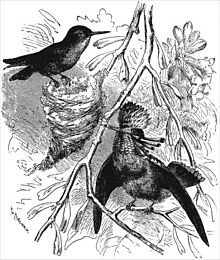Sexual selection - Simple English Wikipedia, the free encyclopedia

Sexual selection is a special kind of natural selection. It is a theory of Charles Darwin that certain traits can be explained by competition within a species.
Darwin defined sexual selection as the effects of the "struggle between the individuals of one sex, generally the males, for the possession of the other sex".[1] It is usually males who fight each other. Traits selected by male combat are called secondary sexual characteristics. They include horns, antlers, which are sometimes referred to as 'weapons'.
Traits selected by mate choice are called 'ornaments'. Females often prefer to mate with males with external ornaments – exaggerated features of morphology. Genes that enable males to develop impressive ornaments or fighting ability may simply show off greater disease resistance or a more efficient metabolism. This idea is known as the 'good genes' hypothesis. Sexual selection is still being researched and discussed today.[2]
One author says studies on sexual selection have something important to tell us, namely "how males and females came to be what they are".[3]
Modern views
[change | change source]Ernst Mayr said:
- "Since Darwin’s days it has become clear that this kind of selection includes a far wider realm of phenomena... instead of sexual selection it is better referred to as selection for reproductive success... genuine selection, not elimination, is involved, unlike survival selection. Considering how many new kinds of selection for reproductive success are discovered year after year, I am beginning to wonder whether it is not even more important than survival selection, at least in certain higher organisms".[4]
Competition between members of the same species
[change | change source]Today, biologists would say that certain evolutionary traits can be explained by competition between members of the same species. Competition can be before or after sexual intercourse.
Competition between males and females
[change | change source]- Before copulation, intrasexual selection – usually between males – may take the form of male-to-male combat. Also, intersexual selection, or mate choice, occurs when females choose between male mates.[5] Traits selected by male combat are called secondary sexual characteristics (including horns, antlers etc.), which Darwin described as "weapons", while traits selected by mate (usually female) choice are called "ornaments".
- After copulation, male–male competition may take the form of sperm competition, the competition between the sperm of two different males to fertilize an ovum.[6] in 1970. More recently, interest has arisen in cryptic female choice,[7] where a female will get rid of a male's sperm without his knowledge. This occurs in a wide range of species.
Sexual conflict
[change | change source]Finally, sexual conflict is said to occur between breeding partners,[3] sometimes leading to an evolutionary arms race between males and females. This is based on the simple fact that the interests of males and females in reproduction are fundamentally different.
Males: their interest is to mate with a large number of completely faithful females, thus spreading their genes widely in the population.
Females: Their interest is to mate with a large number of fit males, thus producing a large number of fit and varied offspring.[3][8]92[9]
Female mating preferences are widely recognized as being responsible for the rapid and divergent evolution of male secondary sexual traits.[10] Females of many animal species prefer to mate with males with external ornaments – exaggerated features such as elaborate sex organs. Alternatively, genes that enable males to develop impressive ornaments or fighting ability may simply show off greater disease resistance or a more efficient metabolism. These features would be likely to be inherited by offspring of both sexes.
Related pages
[change | change source]References
[change | change source]- ↑ Darwin C. 1871. The Descent of Man and selection in relation to sex. John Murray, London.
- ↑ Cronin, Helena 1991. The ant and the peacock: altruism and sexual selection from Darwin to today. Cambridge University Press.
- ↑ 3.0 3.1 3.2 Arnqvist G. and Rowe L. 2005. Sexual conflict. Princeton University Press, Princeton New Jersey
- ↑ Mayr, Ernst 1997. The objects of selection Archived 2007-03-11 at the Wayback Machine Proc. Natl. Acad. Sci. USA 94: 2091-94.
- ↑ Campbell N.A. & Reece J.B. (2005). Biology. Benjamin Cummings. pp. 1230 pp. ISBN 0-8053-7146-X.
- ↑ Parker, Geoffrey A. 1970. Sperm competition and its evolutionary consequences in the insects. Biological Reviews. 45: 525-567. [1]
- ↑ Eberhard W.G. 1996. Female control: sexual selection by cryptic female choice. Princeton, Princeton University Press.
- ↑ Schilthuizen, Menno 2001. Frogs, flies and dandelions: the making of species. Oxford University Press. ISBN 019850392X
- ↑ Crudgington H. & Siva-Jothy M.T. 2000. Genital damage, kicking and early death. Nature. 407: 855-856.
- ↑ Andersson M 1994. Sexual selection. NJ: Princeton Univ Press.


 French
French Deutsch
Deutsch